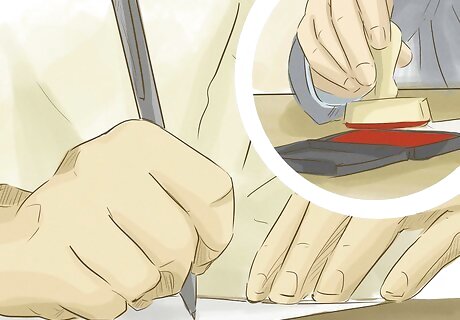
views
Developing Your Arguments

Identify why the defendant seeks dismissal. You should receive a copy of the defendant’s motion to dismiss. Once you receive it, read through the document and look to see why the defendant seeks dismissal. Generally, a defendant seeks to have a case dismissed for the following reasons: You didn’t serve the complaint properly on the defendant. You haven’t stated a valid legal claim in your complaint. For example, you might have sued a neighbor because they painted their house an ugly color. However, your state probably doesn’t allow you to sue for this reason. You forgot to allege a required element of a claim. For example, if you sue someone for negligence, you need to allege four elements in your complaint: (1) the defendant owed you a duty of reasonable care, (2) the defendant breached that duty by falling below the standard of care, (3) that breach was the cause of (4) your injuries. If you forgot to allege causation—the third element—then your complaint is defective. The court doesn’t have power over the defendant (“jurisdiction”) because the defendant lacks sufficient minimum contacts with the state where the case has been filed. The venue is improper. This means the defendant has insufficient contacts with the county or district where the case was filed.

Develop your counterarguments. Before sitting down to draft your motion in opposition, you should think about what you want to argue. You are limited in the counterarguments you can make. Basically, you will simply disagree with whatever the defendant claims. For example, you can argue: You did serve notice on the defendant properly. Find your Proof of Service (or Affidavit of Service). You have stated a valid legal claim. Go through your complaint and make sure you alleged all necessary elements for the cause of action you have brought. The court has jurisdiction over the defendant. You will need to point out the “minimum contacts” the defendant has with the state where you brought the lawsuit. The venue is proper. Venue is proper where the defendant does business there or is a resident.

Talk to whoever made service. If the defendant argues that service was improper, then you should find your Proof of Service form. Also talk to the person who made service. This person may need to testify at the hearing on the motion to dismiss. Tell the server when the court hearing is, if you need their attendance.

Research the law. To help develop your counterarguments, you need to do some research. For example, the defendant might claim he can’t be sued in your state because he only has a business office in the state but doesn’t live there. You will need to find out whether or not that amount of contact is sufficient “minimum contacts” for jurisdiction. Get a copy of any court opinion cited by the defendant. You can find court opinions at your nearest law library, which may be at your courthouse or at a law school. You can also find court opinions on Google Scholar. Click “Case law” and then type in the case citations, e.g. 322 2Fd. 265. Read the cases to make sure the defendant has summarized them accurately. Also find cases that support your position. You can search Google Scholar. Select the courts you want to research and then create relevant search strings. For example, “minimum contacts business office” is a search string.

Meet with an attorney, if necessary. You might feel overwhelmed trying to figure out how to respond to a motion to dismiss. If you need help, or if you have legal questions you need answered, then schedule an appointment with an attorney. Only a qualified attorney can listen to your individual circumstances and offer properly tailored advice. You can get a referral by contacting your local or state bar association. Once you have a referral, call up the attorney and ask to set up a meeting. Also ask the attorney’s fee and briefly describe your problem.
Drafting the Motion in Opposition

Get your local rules. Each court or individual judge probably has rules specifically for their court. These rules will often explain what must go into a motion, such as its form, length, content, etc. You need to follow these local rules. You can usually find them on the court’s website or by contacting the judge’s chambers specifically and asking for a copy. As soon as you get the local rules, read them closely.

Format your document. Begin by inserting your caption. The caption contains the name of the court, the names of the parties, the case number, and the judge’s name. You can find this information on the defendant’s motion to dismiss. Your local rules should contain information about formatting. For example, in many state courts you have to print your motion on “pleading paper.” This is paper which is numbered down the left-hand margin. You should set the font to 14 point, either Times New Roman or Arial. Remember to title your document. You can title your motion “Plaintiff’s Opposition to Defendant’s Motion to Dismiss” or something similar.

Insert an introduction. You can use the first paragraph to briefly explain why you are opposing the motion to dismiss. You should mention that you satisfy the rule of civil procedure regarding complaints. In federal court, this is Rule 8. A sample introduction could read: “Plaintiff, [insert your name], hereby submits its opposition to Defendant’s Motion to Dismiss the Complaint. The Plaintiff’s Complaint not only meets but exceeds the standards governing the form of a complaint as required by Federal Rule of Civil Procedure 8(a). Specifically, this Court has personal jurisdiction over the Defendant, and the complaint sufficiently alleges causation and harm. Accordingly, Defendant’s motion should be denied.”

Make your argument. Your argument will depend on why the defendant is seeking to have the case dismissed. If the defendant believes you haven’t alleged a proper cause of action, then be sure to refer to your complaint and point out where the required information appears. Use the heading “Argument” underlined to set off this portion of the motion. If the defendant claimed you didn’t allege all elements of a claim, then you could write, “Plaintiff’s complaint properly alleges causation and damages in paragraphs 20 through 23, as well as in paragraph 33 and 36.” If the defendant claims the court doesn’t have jurisdiction, you should explain why the court does: “Defendant’s claim that the court lacks personal jurisdiction also fails. As the Supreme Court has held, a court has personal jurisdiction when a defendant has sufficient ‘minimum contacts’ with the forum state. International Shoe Co. v. Washington, 326 U.S. 310 (1954). Here, the Defendant maintains an office in this state, from which he performs regular business, which is sufficient for the court to maintain jurisdiction.”

Add a conclusion. After the argument, you can insert a brief conclusion. You simply need to request that the court deny the defendant’s motion to dismiss. For example, you could write the following: “For the foregoing reasons and all the others discussed in Plaintiff’s Complaint, the present Motion to Dismiss should be denied.”

Attach a certificate of service. You must send the defendant a copy of your motion before you file it. A certificate of service is how you let the court know that you sent a copy of the motion, as is required by your court’s rules. A basic certificate of service might read: “I hereby certify that on [insert date] a copy of the document entitled Plaintiff’s Opposition to Defendant’s Motion to Dismiss was [insert method of delivery, such as mail, postage prepaid] to: [insert address of defendant’s lawyer].” Then include lines for the date and for your signature. If you file electronically in federal court, then your certificate should read: “I hereby certify that on [insert date] I will electronically file the foregoing with the Clerk of Court using the CM/ECF system, which will then send a notification of such filing (NEF) to the following: [insert name and address of defendant’s lawyer].

Create any necessary affidavits. You might need to support your motion in opposition with an affidavit. An affidavit is a notarized (“sworn”) statement as to various facts in support of your opposition motion. For example, you might need to point out that the defendant has a summer home in your county and that he or she spends time there. This affidavit could help you support your argument that the venue is proper or that the court has jurisdiction. See Write an Affidavit for more information about how to prepare this document.

File the motion. Once you have completed the motion, you should assemble it and make several copies. You can file the original with the court clerk. If you are in federal court, then you might file electronically.
Arguing the Motion

Reread all of the motions. At your hearing, the judge might ask you anything—even questions about the defendant’s motion to dismiss. Accordingly, you need to fully understand the issues in dispute. Sit down and reread all of the motions filed. After you filed your opposition, the defendant might have filed a “reply” motion. If so, then there are three motions you need to read. Also go back over your research. Make sure to reread any case you or the defendant rely on.

Sit in on a hearing. If you’ve never argued a motion before, then you should try to watch the judge run a motions hearing. Check the judge’s calendar (which is often online) or contact the court clerk and ask when the judge is holding hearings on the motions. Pay attention to where the parties sit or stand when making their argument. Also note how much time the judge gives each side. If you find that the judge only wants to hear a couple minutes of argument, then you will know to keep your own remarks brief. Listen to the questions that the judge asks. Try to come up with answers if the judge asks these same questions of you.

Make your argument. The defendant will speak first. Listen quietly to his or her arguments. The defendant shouldn’t make any arguments that haven’t been made in the motion to dismiss. If they try to sneak in new arguments, write them down and draw them to the judge’s attention when it is your time to speak: “Your Honor, that’s a new argument that wasn’t made in the motions.” You should probably respond to the defendant’s arguments in the order they were made unless the judge seems particularly interested in one issue. Remember to speak clearly and to address the judge as “Your Honor.” When the judge asks a question, be sure to listen quietly. If you don’t know the answer to a question, don’t guess. Always be honest with the judge.

File the lawsuit again, if necessary. The defendant might win his or her motion to dismiss. In this situation, you can probably refile the lawsuit if the lawsuit was dismissed “without prejudice.” Be sure to check the following: Check that the statute of limitations hasn’t expired. For example, you get three years to file a lawsuit for copyright infringement. The clock starts running from the date of the infringement. You can refile your lawsuit so long as the statute of limitations hasn’t expired. Find what you forgot to allege in your original complaint. The judge might dismiss the lawsuit because you didn’t properly allege a cause of action. Type up a new complaint and include the missing allegations. Find the correct court to file the lawsuit. If the judge dismisses the lawsuit for lack of jurisdiction, you need to find the correct court to sue in. For example, you may have to file the lawsuit in the county where the defendant lives. Meet with a lawyer. You might not know what your next steps should be if the case is dismissed. Promptly schedule a meeting with a lawyer. Don’t delay as the statute of limitations clock continues to tick.




















Comments
0 comment